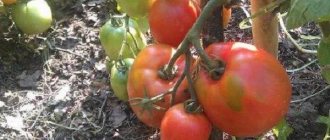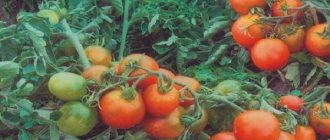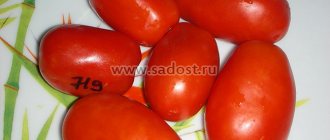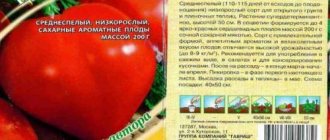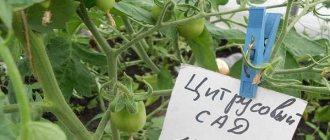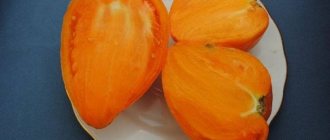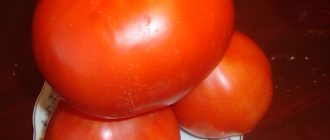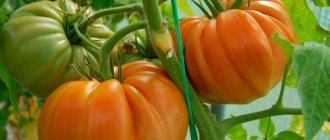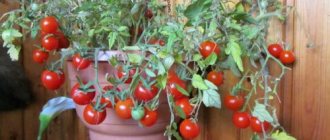The Canary tomato was created specifically for the harsh Siberian conditions. It can grow in a greenhouse, even if there is little sunlight, and is tolerant of other unfavorable conditions. Large fruits have excellent taste.
| Height | Landing location | Ripening time | Fruit color | Fruit size | Origin | Fruit shape |
| Tall | Greenhouse, Open ground | Mid-season | Reds | Large | Variety | Flat-round |
Tomato Palace
In addition, the tomato will be an excellent addition to the salad, as well as as a separate slice.
In the absence of natural lighting, artificial lighting is used. Proper planting is only half the way to getting a rich harvest.
Caring for planted tomatoes is no less important: Canary tomatoes have strong immunity. Almost all fungal, bacterial and infectious diseases are not dangerous to the plant, including insect pests.
To publish messages, create an account or log in
To prevent diseases and pests, the soil around the bush is watered with copper sulfate, and the crown with insecticides. There are other, no less large and unpretentious varieties, similar in characteristics and descriptions to Canary tomatoes:. Among the disadvantages, vegetable growers note the need for strong supports due to the weight of the fruits, as well as frequent feeding.
Any description stated by the manufacturer does not always correspond to reality. Therefore, for greater confidence in the quality of Canary tomatoes, gardeners turn to reviews from experienced gardeners: Every year the bushes delight with an excellent harvest.
The fruits ripen fleshy, juicy and very large. The maximum weight grown in my garden is g. As a result, after careful selection, I opted for Bull's Heart, Syzran Rose and Canaries. The latter never failed and sprouted like clockwork. Fruiting and ripening occur evenly.
The tomatoes are always selected, juicy and elastic. Most often I make preparations from them for the winter, but the fruits have to be cut, because due to the enormous mass of one piece, they do not fit into the jar entirely. The tomatoes clearly did not reach the weight indicated in the description of the variety in grams, having stopped growing at grams. Perhaps I chose bad seeds, since my neighbor, who bought grains from another company, turned out excellent tomatoes. I have nothing against the taste and quality of the fruits - the vegetables grew juicy.
Next year I'll try again, this time I'll buy another company.
Advantages and disadvantages of the variety
The advantages of growing Canary tomatoes, which the manufacturer highlights:
- the variety is frost-resistant;
- unpretentious to lighting;
- strong immunity to diseases and pests;
- large fruits;
- long fruiting;
- simultaneous maturation;
- rich taste and aroma;
- long shelf life;
- suitable for a variety of dishes;
Among the disadvantages, vegetable growers note the need for strong supports due to the weight of the fruits, as well as feeding during flowering and fruit set.
Description of the northern hybrid tomato Canaries, growing and caring for the plant
The Canary tomato is extremely popular among gardeners in northern latitudes and areas with limited daylight or a consistently rainy climate.
A special feature of the variety is its ability to grow and bear fruit in conditions of insufficient natural light. The hybrid was grown in Novosibirsk and intended for cultivation in greenhouse conditions.
In warm climates it can also be planted in open beds.
Main characteristics of the variety
Tomatoes have an average ripening period. Depending on the climate zone, it lasts 110-120 days. Plants are limited in growth, which is 200 cm in greenhouses and 160 cm in open beds. Therefore, for the variety it is necessary to arrange individual supports or trellises.
The trunk is strong and flexible. The root system is well developed, wide and deep. The crown is sparse, the foliage is medium-sized, dark green. Thinning is not required, since the fruits are well lit.
Characteristics of Canary tomato fruits:
- shape – regular, spherical;
- average weight – 600 g, some specimens reach 800 g;
- color – red, uniform;
- peel – dense, shiny;
- pulp – fleshy, sugary;
- taste – rich, without sour aftertaste;
- keeping quality – average.
Reviews from gardeners indicate that the yield of the variety deserves all praise. With a competent approach to growing and caring for the bush, you can harvest up to 10 kg per season.
In cooking, the fruits are used to make juice, adjika, ketchup and lecho. Served fresh, sliced or in salads. Tomatoes are not suitable for canning in jars due to their gigantic size. However, they are well preserved in barrels when salted.
The manufacturer's description of the properties regarding the immunity of the variety corresponds to reality. Plants are resistant to almost all types of fungal and infectious diseases.
Advantages and disadvantages of the variety
The main advantage of Canary tomatoes is that they tolerate low temperatures well, which are not uncommon in Siberia and the Urals even in summer.
In addition, tomatoes have the following advantages:
- large size, which immediately arouses interest in the product;
- good resistance to pests and infections;
- undemanding to the lighting mode;
- possibility of long-term storage;
- wide range of culinary uses;
- amicable maturation;
- long fruiting period;
- high taste qualities.
Gardeners note that growing the variety requires some effort. Tall and heavy bushes need powerful and stable structures to support them. Since the plant itself and the fruits are large, frequent fertilization is necessary.
Growing and caring for plants
You need to plant the seeds in early March. For seedlings, factory-made peat tablets or wooden boxes filled with fertile soil are taken. Drainage is placed at the bottom of the containers to regulate the humidity level.
The soil itself is made from garden soil, peat and organic fertilizers. Before planting, the seeds are soaked in a nutrient solution until they hatch. They are immersed 1 cm in the ground and immediately irrigated with water using a spray bottle. As a rule, shoots appear within a week.
Seedlings should be grown for at least 2 months. She needs 10 hours of natural light per day. If there is not enough light, then lamps are used. The room temperature must be maintained in the range of +19…+21°C.
A week before replanting, the plants should be hardened off. Each cycle lasts 2 hours with a gradual decrease in temperature.
Seedlings are planted in pre-prepared holes with a fertile mixture of peat, fertilizers and wood ash. After the seedlings are accepted, a strong rope is tied to the base of each bush. The bush will wrap around it and stretch out. During the first week, you need to water the plants daily, then as needed when a hard crust forms on the soil.
To get a good harvest, the bushes need to be constantly looked after. Tomatoes should be fed at least 2 times a month, alternating organic matter, mineral and combined fertilizers.
To maintain aeration of the root system, regular loosening and mulching of the soil is carried out.
Protection of seedlings from parasites is carried out comprehensively: by pouring copper sulfate into the soil around the bushes and spraying the upper part of the plants with insecticides.
With proper care and good weather, you can count on the first harvest by the end of June or beginning of July.
Reviews about the variety
- Elena, 44 years old:
I’ve been planting the “Canary” variety on my plot for three years. I like this variety because of its ability to thrive in low light conditions. This is what I needed, since the site is located in the shady side. The culture produces beautiful, large, fleshy fruits. They're delicious. I use them both fresh and for pickles, marinades, and snacks. - Grigory P., 27 years old:
I really like the Canary variety: unpretentious, resistant to weather changes, especially low temperatures. In addition, it does not require much sunlight and thrives in the shade. I feed it a couple of times a month with organic matter and minerals, and water it. Their departure is everything. As a result, I get a good harvest, which pleases our whole family. I recommend trying to grow this variety of tomatoes on your site.
Kazakhstan yellow tomato - description and characteristics of the variety
Description of the tomato variety Zhenaros and its characteristics
Tomato Zhenaros f1 was the brainchild of Dutch breeders. The variety is popular among Russian vegetable growers. The hybrid is listed in the State Register and is known for its high yield.
General information about the variety
The plant reliably bears fruit in greenhouse conditions and in open ground. Description and characteristics of the variety:
- mid-early, maximum variety of tomato ripening up to 124 days;
- indeterminate;
- high yield, up to 12.7 kg of berries per 1 sq. meters in greenhouse conditions;
- medium height, maximum height 70 cm;
- simple inflorescence;
- average foliage of the bush;
- the first inflorescence is formed after the 9th leaf;
- high resistance to major diseases of the nightshade family;
- heat resistance;
- good berry set;
- maximum shelf life 12 days;
- unpretentious, able to bear fruit in poor soil conditions.
The tomato is suitable for cultivation in different climatic zones. A distinctive feature of the variety is resistance to extreme conditions. In addition to Russia, it is successfully cultivated by Moldovan and Ukrainian gardeners.
- flat-round or round shape;
- high density;
- slightly ribbed;
- glossy;
- ripe berries acquire a red color;
- large, maximum weight of ripe berries is 270 grams;
- fleshy;
- sweet;
- fragrant.
Hybrid tomatoes are suitable for canning, making pastes, purees and juices. The berry will be an excellent addition to a vegetable salad.
Recommendations for cultivation
To obtain a better harvest, it is recommended to grow tomatoes in greenhouse conditions. Under suitable climate conditions, the variety successfully bears fruit in open ground conditions. The optimal planting method is seedlings.
To obtain healthy seedlings you should:
- plant seeds in containers with universal soil for tomatoes no deeper than 2 cm;
- after planting, cover containers with seedlings with film;
- maintain the room temperature at least 20 degrees;
- water regularly;
- After the first shoots appear, provide a constant source of light.
IMPORTANT! To get the best harvest, you need to form a bush of 1-2 stems. Plants should be hardened off before planting
When planting, the recommended pattern is 50 x 40 cm. Per 1 sq. There should not be more than four tomato bushes per meter of land. The variety is not whimsical, it requires only basic rules of care:
Before planting, plants should be hardened off. When planting, the recommended pattern is 50 x 40 cm. Per 1 sq. there should not be more than four tomato bushes per meter of land. The variety is not whimsical, it requires only basic rules of care:
- watering with warm water as needed;
- loosening and weeding;
- feeding with complex mineral fertilizer, at least 4 times during the summer season.
https://youtube.com/watch?v=pwxBh2nZiOs
Gardeners' opinion
Growing tomatoes is my hobby. I recently tried the Zhenaros variety. The impression is positive. For a hybrid, the fruits have an excellent taste and are sweet. The berries are large and regular in shape. The plant bore fruit without difficulty in the Moscow region. I planted the seedlings in a greenhouse, watered them regularly, fed them 5 times, and loosened the soil. I didn’t find any shortcomings for myself.
Victor Grabinin, 47 years old.
Good afternoon! I want to share my experience of growing Zhenaros tomatoes. Medium early, grows well even on poor soils. The gloomy St. Petersburg summer did not prevent us from getting a good harvest. Stress-resistant plant, not capricious. One of the features is that it is necessary to carry out pinching; it is better to form it into one bush. The berries are large, juicy and sweet. My positive feedback to the Dutch breeders. I recommend it to all summer residents!
Description of the Zero tomato variety, its characteristics and yield
At the beginning of summer, when the body lacks vitamins, early tomatoes are needed more than ever. Tomato "Zero" is suitable for this purpose; its yield is very high. And relatively small fruits are suitable for any purpose.
Basic ideas about the variety
To avoid mistakes when growing, you need to carefully study the description of the tomato. This information will make it possible to grow a healthy plant, while increasing the yield.
- Determinant.
- Simple inflorescence.
- Ripens in 100-110 days.
- Its height is 60 cm.
- Round shape.
- Yellow color.
- There are 6 cameras, sometimes more.
- Density is low.
- Weight depends on the manufacturer: Sedek 120-160 gr., State Register 230-260 gr.
- It is stored for a long time and can withstand transportation.
How to plant and care for a plant correctly
Suitable for growing in open ground and greenhouses. Seeds for seedlings are planted 60 days before transplanting to a permanent place
It is important to take into account the climatic features of your region
As soon as the 2nd true leaf appears, the seedlings dive. Separate pots are prepared for this. This is necessary so that the plant forms a stronger stem and is ready for replanting.
Timely feeding with growth-stimulating drugs will give the plant strength to develop
It is important not to overdo it, moderation is observed in everything
Up to 7 plants are planted per 1 m2. At the same time, as they grow, they are necessarily formed and tied to supports. Leave 2-3 stems, this will increase the yield.
All other agricultural techniques for care are similar to any other variety.
Diseases characteristic of the species
Tomato varieties need treatment against diseases. Begin from the very beginning of disinfection of seed material. To do this, before planting, they are kept in a weak solution of potassium permanganate. Then, as the plants grow, they are treated with chemicals. But only before flowering. Afterwards it is advisable to fight using folk methods.
What are vegetables used for, harvest volume
Zero tomatoes are excellent for dietary nutrition. In addition, they are used for any type of canning. As well as preparing fresh salads, soups and much more. Suitable for marinating as a whole.
The yield of the variety is about 7 kg per 1 m2. Since the variety is resistant to temperature changes, it bears fruit regardless of climatic conditions.
Positive and negative properties of tomatoes
The presence of positive characteristics is decisive for most summer residents when selecting varieties.
- Resistant to temperature changes.
- Productivity.
- Unpretentiousness.
- The fruits do not crack and are stored for a long time.
- Used in dietary and baby food.
Requirement for formation.
The opinion of summer residents regarding the “Zero” tomato variety
Many gardeners provide invaluable assistance to beginners by leaving reviews about species on websites. They share experiences, impressions, give advice and recommendations.
Antonina Valerievna. I planted tomatoes for the first time. I did not regret purchasing this variety. The taste is excellent, if it shows itself well in preparations for the winter, I will definitely plant more.
Growing early tomatoes is necessary, since their consumption compensates for the lack of certain vitamins in the body after winter.
Unsurpassed yields in the harshest conditions - Canary tomato: characteristics and description of the variety
The Canary tomato was created specifically for the harsh Siberian conditions. It can grow in a greenhouse, even if there is little sunlight, and is tolerant of other unfavorable conditions. Large fruits have excellent taste.
| Height | Landing location | Ripening time | Fruit color | Fruit size | Origin | Fruit shape |
| Tall | Greenhouse, Open ground | Mid-season | Reds | Large | Variety | Flat-round |
Description and characteristics of the variety
Canary tomato bushes are indeterminate, reach approximately 2 meters and require staking. They grow well in both protected and unprotected soil.
The fruits ripen in an average period of 116-120 days from the moment of emergence. These are large flat-round beefsteak-type tomatoes weighing 160-200 g. But according to other sources, you can get tomatoes even weighing 800 g each. The color is red, the flesh is fleshy, aromatic, sweet.
Small fruits can be harvested for the winter, the rest can be eaten in the form of salads, added to dishes and processed.
Advantages and disadvantages
- excellent taste and tender pulp;
- beautiful large fruits;
- high productivity;
- shade tolerance;
- resistance to cold weather;
- disease resistance;
- pest resistance.
Minuses:
Productivity
From 1 sq. m get about 10 kg of fruit.
Landing
To grow a tomato in open ground, seeds are sown for seedlings 60-65 days before transferring to the garden bed; for greenhouses - 50 days before. Before sowing, the seeds are treated in turn with solutions of potassium permanganate and a growth stimulant. The soil and containers for planting are also disinfected.
The seeds are buried to a depth of 1-1.5 cm. Until germination, they are kept warm under glass, then opened and transferred to a well-lit place with a temperature of +18-22. During the first 3 days, the temperature is needed around +14-16 so that the sprouts harden and do not stretch. In the 2-leaf phase, picking is required.
The site is prepared in the fall by clearing old tops, digging and fertilizing. Tomatoes need loose, breathable soil.
Growing and care
Bushes require shaping. The lower side shoot (stepson) is left and the bush is led into 2 trunks. The remaining shoots are cut 2.5 centimeters from the stem. Excess brushes are also removed, leaving no more than 6 on the main stem. Do not leave more than 5 fruits on the clusters so that they do not turn out small.
Water the tomatoes as the soil dries, regularly, in the morning or evening. For irrigation you need warm, settled water.
Feed several times a season with an interval of about 2 weeks. At the beginning of growth, organic matter is added, then special mixtures containing phosphorus and potassium, as well as calcium (to avoid blossom end rot).
Tomato Mona Lisa - description and characteristics of the variety
Variety reference
Breeders have created this hybrid variety, which can be fed in open beds or under film covers. It is also possible to grow in unheated greenhouses, but in this case the bushes become elongated and the tomatoes succumb to blossom end rot.
- Hybrid variety of early ripeness (time from germination to harvest is 95 days).
- The seedlings are semi-determinate, reach a height of up to 130 centimeters, in greenhouse conditions they can reach up to 180 centimeters and higher.
- It gives a consistently high yield - up to 20 kilograms of ripe tomatoes can be harvested from one square meter.
- The number of leaves is average.
- The coloring of the stems and plates is pale green.
Growing seedlings
This variety can be grown independently.
For open soil, only seedlings aged 60–65 days are suitable. In greenhouse conditions it can be planted a little earlier, at the age of 50 days. Seeds are sown in early March in special containers, seedling boxes, one to one and a half cm deep. It is important that the soil is loose and airy. This is required for normal growth and maturation of seedlings. Already a week after planting, shoots appear. When a couple of true leaves appear, the seedlings can be planted in an open area in the soil.
Description of the variety
Fruit:
- Rounded in shape, flattened at the top and bottom, with medium ribbing;
- Unripe ones are light green in color; those that have reached varietal ripeness are pink;
- With dense, smooth skin;
- With tender, juicy pulp, with numerous seeds;
- The number of seed chambers is from 4 to 6;
- Low dry matter content;
- Large sizes. Average weight is approximately 300 grams or more.
Bushes:
- Indeterminate, non-standard plant, with a strong, well-leafed stem. With a powerful, developed rhizome;
- It reaches a height of more than two meters;
- The leaves are large in size, dark green in color, tomato-type, wrinkled, with no edge;
- The inflorescence is simple, intermediate type. The formation of the first inflorescence occurs above the 7-8 leaf, further ones at intervals of 1-2 leaves;
- The peduncle has an articulation.
Cultivation
Sowing of seeds is carried out taking into account the growing season of tomatoes. When transplanting a crop to a permanent place, you should definitely make sure that on the selected plot of land the seedlings will not be exposed to the sun throughout the day.
Since the plants belong to the tall type of nightshade crops, it is worth taking care of supports in advance. Timely tying up of seedlings will significantly reduce the risk of fungal and infectious diseases on tomatoes. In order for the fruits to ripen on time, an equal distance of 50 cm is maintained between the bushes. Row spacing is created with an interval of 60 cm.
To get a good harvest, it is important to constantly monitor the pH of the soil. It should be no lower than 6, but no more than 6.7 units
During the entire period of cultivation of Golden Canary tomatoes, the seedlings must be fed three times with complex fertilizers. It is also necessary to regularly introduce calcium solutions into the soil, which actively affect the growth of foliage and stems.
Important! During the period of abundant flowering, experts recommend not introducing preparations with a high calcium content, as this may have a detrimental effect on the future yield of the variety.
When the plants begin to bloom, you can fertilize the soil with compost. Many summer residents insist that when transplanting tomatoes into permanent soil, the seedlings must be buried down to the first leaves. This technique allows tomatoes to quickly take root and helps to tolerate prolonged droughts favorably, and thanks to the extensive root system, the seedlings will be able to receive the required moisture from the lower layers of the soil.
Advice! It is better to mulch the top layer of soil with straw or sawdust. Mulch will help maintain the necessary moisture and temperature in the soil.
Bush formation
When tomatoes are planted in a place of permanent growth, in the ground or in a greenhouse, the first thing to do is tie the twine. It is along this path that the entire bush will grow. In accordance with the growth of the stem, twine is twisted around the crop. At the same time, additional shoots appear in the axils of the leaves. They are called stepchildren. Only one is left for further growth, the others are removed. The length of the stepsons should not exceed 2.5 cm.
The Canary variety should be characterized by the presence of no more than 6 branches. On each of them the number of fruits does not exceed 5. The weight of one fruit is no more than 160 grams.
Kazachka tomato - description and characteristics of the variety
Advantages and Disadvantages of Culture
The main value of the culture is its taste. When fully ripe, tomatoes become redder, the flesh acquires a jelly-like structure and characteristic fruity notes of taste. In good conditions and with the right agricultural technology, you can grow tomatoes weighing up to 700-800 g. On average, they are also not small - 150-300 g. The fruits on one bush are even in size.
Attention! In the greenhouse, the tomato showed better yield compared to an open bed in the garden: 9-10 clusters of 5-6 fruits versus 8 clusters with 5 tomatoes each. Flaws:
Flaws:
- Extended unfriendly maturation.
- The difficulty of cultivating tomatoes in regions with cool climates and short seasons. The ripening period for Canada varies between 110-120 days.
- Not the best keeping quality. The not very dense pulp does not allow tomatoes to be stored for a long time and transported over long distances.
- The bush requires correct formation and regular removal of stepsons. Without a garter, a tomato will also not be able to bear fruit normally.
- A small amount of seeds. It is difficult to collect 2-3 seeds from one bush, and only from a late harvest.
Description of the Kasamori tomato variety and its characteristics
The ultra-early ripening pink-fruited tomato Kasamori F1 of Japanese selection has recently been present on the Russian market, but has already become a favorite of vegetable growers who grow tomatoes in greenhouses for early production. In Japan, high demands are placed on the consumer and technological qualities of tomatoes cultivated under production conditions. The Kitano Seeds company and its hybrid Kasamori are no exception. High quality hybrid.
About the hybrid
The bush is of indeterminate type with shortened internodes, which is why it is compact. Recommended for growing in spring film and winter greenhouses. Ripens quickly, on the 90-100th day from germination. The available description of the fruits indicates that they are very large, over 200 g, bright pink in color, intended for salad purposes, and are suitable for sale on the fresh produce market. The shape of the fruit is flat-round, there are more than six seed nests. The fruits are formed in clusters of 5-6 pieces. Reviews from gardeners indicate that the fruits are never smaller than 200 g. On average, their weight is from 270 to 300 g, and the maximum is 550 g. The surface is even and smooth, a green spot does not form on the stalk, and no cracks in the fruit were noted.
Distinctive features of the hybrid
Vegetable growers with experience in growing this hybrid noted a number of its positive properties:
– good fruit set in any conditions, including stressful ones;
– high yield, an average of 4 kg of fruits are obtained from one bush;
– the possibility of growing in all types of film and glass shelters, including temporary ones, and in open ground.
Experts note the high plasticity of the Kasamori tomato; its characteristics allow it to be grown at all times of the year. The short production period is Kasamori's advantage.
Advice: plant seedlings of this hybrid at several times, as well as seeds directly into the soil for a seedless crop. The last fruits can be collected at the end of September and ripened at home. They do not lose their taste when harvested in the milky-waxy ripeness phase.
Growing seedlings
The timing of sowing seeds for seedlings depends on where the plants are planned to be planted in a permanent place. The following options are possible:
- in a spring heated greenhouse, sowing is done in mid-February;
- in a spring unheated greenhouse - at the end of February;
- in open ground - in the first ten days of March;
- direct sowing in open ground in two periods - at the end of April and at the beginning of May;
- direct sowing in open ground using an autumn mobile greenhouse - at the end of May.
Tomato seedlings need to be fed every 10-14 days. They accept humic-based fertilizers well. If there is a lack of light, the plants are illuminated with a phytolamp.
Caring for tomatoes in a greenhouse
The main maintenance work includes watering, weeding and loosening, fertilizing and shaping bushes. Tomato plants in a greenhouse need to be watered twice a week, and every other day during hot periods. After each watering, the soil must be loosened and weeds must be removed at the same time; they can be carriers of pests and diseases.
It is better if the soil in the greenhouse is mulched with peat, sawdust or any other material. Formation of a bush includes pinching of plants. Stepchildren must be removed until they exceed 2-2.5 cm, always with a disinfected instrument, for example, scissors. The plant forms into one stem. Weighty brushes need additional tying.
How to grow seedlings with your own hands?
The age of seedlings for planting in open ground should be 60–65 days; 50-day-old seedlings are suitable for greenhouses and film greenhouses. Sowing is carried out in the first ten days of March in boxes or cassettes with light permeable soil to a depth of 1–1.2 cm. Shoots appear on days 5–7. When 1-2 true leaves are formed, the seedlings are picked. The characteristics of Canary tomatoes indicate that you can save space when picking seedlings and plant a little more plants. For example, according to the 8 x 8 cm pattern.
Similar varieties
There are other, no less large and unpretentious varieties, similar in characteristics and descriptions to Canary tomatoes:
- Belmonte. Mid-season, indeterminate variety. The fruits are flat-round, fleshy, with a small number of seeds, weighing 0.5-1 kg. Color – pink or red. The average height of the bush is 200 cm. Suitable for open ground and greenhouses. Used for salads.
- Bulgarian miracle. The ripening period is average. Indeterminate. The fruits are large, flat-round, juicy, fleshy, weighing 500-700 g with a pink tint. The height of the bush is up to 200 cm. In the middle zone it is grown in greenhouses, in the south - in open ground. Suitable for salads, juices, sauces.
- Your Honor. Long-term yielding variety. Fruits up to 1 kg, large, elastic, pink, flat-round. The bush reaches 150-200 cm. Planting is possible in greenhouses and in garden beds. Used for pickles and salads.
- Pink giant. The medium-sized bush is suitable for planting in shelters in the southern regions. Height – up to 170 cm. Tomatoes – large, juicy, pink-red. Weight – 0.4-1.2 kg. The disadvantages are that the skin often cracks and has poor shelf life.
- Sprint timer. Determinate subspecies. Tomatoes with an average weight of 700 g, large, heart-shaped, red, sweet. Height up to 1.5 m. Support required. Suitable for salads and juices.
- Syzran rose. Indeterminate. The weight of tomatoes reaches 400-600 g. The fruits are aromatic, large, irregularly rounded, red, with sugar on the cut. The skin is thin and often bursts. The taste is excellent with a slight sourness. The length of the plant is 180 cm. It has a salad purpose.
- Shuntuk giant. The species is mid-ripening, indeterminate. Tomatoes up to 1500 g, flattened, ribbed, red with a strong aroma and pleasant taste. The height in greenhouses is about 200 cm. They have strong immunity.
- Tomatoes Japanese crab. Large-fruited mid-season subspecies. The fruit is flattened, ribbed, red or pinkish in color with juicy pulp and thin skin. Fruit weight – up to 800 g. Stem length 180 cm.
Features of agricultural technology
At first glance, caring for tomatoes is not difficult: you can plant them outside greenhouses, most diseases are not scary. However, some stages of cultivation require attention.
Flower bed design. TOP 10 simple and effective techniques
- By the end of March, the seeds should already be prepared and sown.
- Seedlings require long-term lighting; it is recommended to use a lamp and choose the sunny side.
- Feeding with mineral compounds.
- It is better to mulch with rotted sawdust.
- Tomatoes can be planted densely, but not more than 8 per m2.
- The garter is necessary immediately, because... the fruits are heavy for the stems.
- You need to form 2 stems, but many gardeners leave 1 more. This helps to increase the yield.
- You should not leave more shoots, otherwise the fruits will be sparse and will not reach the expected size.
It is better to water in the morning, making sure that the water gets only under the roots. If there is a risk of early frost, unripe tomatoes are collected and left to ripen in boxes. The tomato captivates with its bright taste and persistent character. Recommended for juices and salads.
Recommendations from experienced vegetable growers
Below are some tips and clarifications from experienced vegetable growers that may be useful to those who are growing vegetables for the first time and this variety in particular.
- The Canary variety has several varieties. The tomato variety most closely matching the description in the registry is from. It is distinguished by powerful, strong bushes and stems. The fruit sets beautifully. The plant has good immunity: it is not affected by pests or diseases.
- To get the best results in growing the Canary variety, it is recommended to apply organic and mineral fertilizers every 2 weeks.
- To obtain large-sized fruits (up to 600 grams), you should purchase tomatoes from the Siberian Garden. Form the bush into 2 stems.
- It is recommended to place 3 bushes per 1 square meter.
The Canary tomato variety is worthy of attention. For those who prefer large, fleshy fruits, this is an excellent option. The variety is easy to care for and produces a good harvest.
What fruits
Breeders give the following description of the fruit:
- color – red;
- shape – round, slightly flattened;
- there is no spot on the stalk;
- the skin is dense, not rough;
- high resistance to cracking;
- the pulp is juicy, the consistency resembles a watermelon;
- the taste is bright, with sourness;
- “tomato” aroma, strong;
- weight – up to 300 g.
The authors of the hybrid recommend consuming the fruits fresh. They are delicious sliced, salads, and juices. Gardeners have made their own additions: they prepare pastes, lecho, and can the whole thing.
There are varieties similar to the Mona Lisa: Leningrad Chill, Wind Rose. They have related characteristics: early ripening, taste, resistance to diseases. The transportability of the Wind Rose is somewhat lower.
